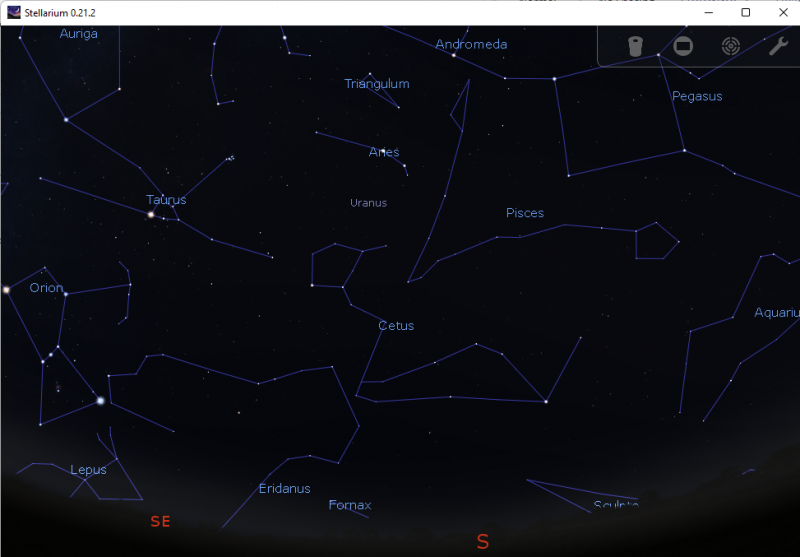2021 December 1
Observer’s Challenge – The Moons of Uranus
The planet Uranus is relatively easy to observe, presenting a small bright disc in a telescope. Uranus is currently in the constellation of Aries and was at opposition on November 4th. It remains well placed for observation from the UK and other northerly latitudes, attaining an altitude of at least 51 degree from the southern UK during December, Fig 1 (Stellarium).

This challenge is not concerned with the planet itself, rather its moons. These are harder to observe, in part as they are so much fainter, but also as the glare of the planet can make them hard to see. The system is especially interesting as its axis of rotation and the orbit of the moons are nearly perpendicular to the plane of our solar system. At the current location in its orbit, the planet and moons are not quite face on, but we none the less we see the moons go around the planet as if observing from above. Planetarium software such as Stellarium (https://stellarium.org/) will show you the location of the moons and can be used to check the apparent size of the system with different eyepiece combinations for a given telescope. The following table gives details of the five major moons with their magnitudes on 1st December 2021 and approximate maximum angular separation from Uranus.
| Name | Diameter | Magnitude | Max Separation |
| Oberon | 1,520 km | 14.3 | 43” |
| Titania | 1,580 km | 14.0 | 32” |
| Umbriel | 1,170 km | 15.1 | 20” |
| Ariel | 1,160 km | 14.5 | 14” |
| Miranda | 470 km | 16.6 | 10” |

Visually you will need a telescope of around 8-inches to observe Titania, the brightest of the moons. If you are using planetarium software then care must be taken not bias your observation with the expected location of the moons. Dr Paul Abel, Director of the BAA’s Mercury and Venus Section, observed three of the moons with a 305mm Newtonian Reflector on 25th October, Fig 2. I tried this challenge with a 10-inch reflector on 22nd November. A bright moon and haze made it difficult to see the moons, though I saw Oberon and an occasional hint of Titania. It is a good idea to try out different eyepieces to see which give the best contrast. A higher magnification can help in this regard, by darkening the sky background. I found a magnification of x347 gave me the best results on the night. Averted vision can also help with these faint targets. Experiment to see what works best for you, take plenty of time, and why not have a go at sketching the location of the moons.

If you are setup for imaging then see how many of the five major moons you can capture. WinJUPOS (http://jupos.org/gh/download.htm) has a handy feature for identifying planetary satellites in images and also has an excellent ephemerides function. Peter Tickner obtained a fine view of them with his 14-inch LX200 on 16th November, Fig 3. If you have a large telescope and good skies, then you could see how many or the fainter moons you are able to detect. Paul Leyland managed to image the small moon Sycorax, just 160 km across with a magnitude 20.7 on 14th September 2020 using his 0.4m Dilworth Relay, Fig 4.

However you observe Uranus and its moons, don’t forget to publish your observations on your BAA members page, and submit them to the Saturn, Uranus and Neptune Section.
Andy Wilson
With thanks to Paul Abel and Pete Lawrence who gave kind permission to use this idea from their 2021 BAA Winchester Weekend Challenges, and to Mike Foulkes Director of the BAA Saturn, Uranus and Neptune Section for suggesting improvements to this article.
Teaser image by Peter Tickner on 25th October 2021 using a 14-inch LX200.
| The British Astronomical Association supports amateur astronomers around the UK and the rest of the world. Find out more about the BAA or join us. |
